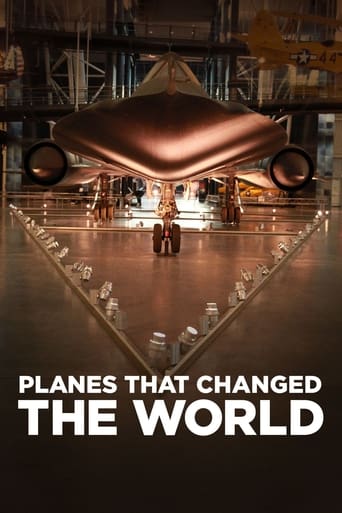
Giants of the Air
We take them - the jumbo jets - for granted today, yet overwhelming obstacles had to be overcome to first get these giants off the ground. The challenge to build larger aircraft has tantalized designers and pilots since the dawn of aviation. Meet the visionaries who overcame these obstacles: Sikorsky, Caprioni, Howard Hughes and others...the pioneers who forged ahead to find the mix of size and engine power necessary to fulfil their dreams - and the quest for yet larger and larger aircraft.
Country: GB
Language: En
Runtime: 60
Season 1:

From the Wright Brothers' first controlled-powered flight in 1903 to the advent of the space shuttle - come to know the key figures in aviation history - the people and the machines that pushed the limits of daring and technology to find ways to fly faster, higher and farther. Here is a chronicle of the raw determination and pioneer spirit that carries Louis Bleriot across the Channel in 1909, and, more recently, carried Dick Rutan and Jeana Yeager around the world in their Rutan Voyager on a single tank of fuel

This is the account of the master aviators who pushed back the frontiers and found new ways to use aircraft...of test pilots, who displayed that rare combination of qualities: coolness under pressure, courage, flying skill, technological knowledge, and military acrobatics. About pilots who pushed their aircraft to the peak of performance...and of the barnstormers and flying circus performers who demonstrated their daring from country airfields to Hollywood film reels, where all the world could witness their dazzling magic. Notable appearances include former test-pilot Bob Hoover and the first female Boeing 747 flight commander Lynn Rippelmeyer.

Over France in World War I, where man and flying machines were first forged into a formidable fighting unit. At the start of the war, the adversaries could muster only a few hundred frail aircraft between them. Yet, in less than 4 years, Britain had commissioned an independent Air Force, had built over 50,000 aircraft and trained 26,000 pilots for observation, strafing, bombing and whatever was necessary to protect its air space. Then, when Anthony Fokker mounted a machine gun on an aeroplane, he changed the face of war forever.

Since the Second World War, aircraft have played an important role in naval operations...defending the fleet against attack by making it possible for pilots to spot the enemy beyond the horizon. The advantages of naval air power became indisputable with the advent of the aircraft carrier - and the expanded capability to deploy this tactical asset across the vast stretches of the ocean. Having proven themselves from the sinking of the Bismarck to the Pacific War, from Suez and Vietnam to the Falklands, here is military air technology at its most daring, where precision is crucial, and the interface between man and machines reaches the ultimate intimacy.

Dresden...London...Vietnam...Tokyo..their names alone are dramatic testimony to the awesome power of the bomber. These aircraft came to dominate military strategy during World War II, and still played a critical role in the cold war. Even today, one side finds new ways for the bomber to do its jobs, as the other side seeks ways to stop it. From the activity on board to the devastation below, reaching for the skies looks at the bombers, the pilots who fly them, and the struggle between nations to maintain the ultimate combination of weaponry and technology...a chilling reminder of the ability aviation has given to society to annihilate itself.

Few aspects of the history of aviation match the vitality, drama and scale of the World War II fighter planes. As the strategists discovered the advantages of these warships of the skies, armies rarely moved across the battlefield without the security of air cover. This episode evokes the life and times of the fighter pilot and his aircraft, from World War II to the present...of individual determination and technological innovation working together in synchronous perfection. From Korea to the Middle East, to Vietnam, here is the testing ground for skill, technology, and, above all, human courage and self-sacrifice.

We take them - the jumbo jets - for granted today, yet overwhelming obstacles had to be overcome to first get these giants off the ground. The challenge to build larger aircraft has tantalized designers and pilots since the dawn of aviation. Meet the visionaries who overcame these obstacles: Sikorsky, Caprioni, Howard Hughes and others...the pioneers who forged ahead to find the mix of size and engine power necessary to fulfil their dreams - and the quest for yet larger and larger aircraft.

The development of the jet engine represented a quantum leap in aviation, and revolutionised commercial aviation. Although first developed for fighter aircraft, this engineering triumph changed the world and led to the development of the jet airliner - especially the one which would set the pace for long distance air travel for the next decade - the Boeing 707. Thereafter America supplied the world with jet transports, creating the international network of air routes upon which the whole world has come to depend. Then Europe responded with the Concorde.

This film begins with the SR-71 Blackbird, expressed as the ultimate expression in the quest for speed. The film, after credits, begins with the 1905 Curtiss biplane, owned and flown by a venerable gentleman who had been a boy when the aircraft was new. Thereafter the film moves on the Schneider Cup competition, and features unique footage of the Napier Lion-powered Supermarine S.5 with its blood-curdling scream over the water. Concluding the Schneider Cup is the S.6 and S.6b.

Examining the history of vertical flight, the program begins with the early helicopters, and then deals the with the pivotal breakthrough of the Cierva Rotor-head, followed by an explanation by the modern master of the Autogyro, Ken Wallis accompanied by the last movement of Bach's 3rd Brandenburg Concerto. Thereafter we move forward to Igor Sikorsky's helicopter, with interview with the great designer at the time of its development. Thereafter the focus moves then to the two great periods of helicopter lifesaving, the Korean War and Vietnam, where the helicopter truly went to war and heroes were made. The calm recollections of several very decorated veterans of the conflict make for compelling viewing, combined with previously unseen film footage of the conflict.






















